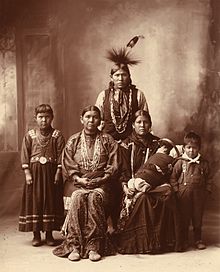Sauk people

The Sacs or Sauks are a group of Native Americans of the Eastern Woodlands culture group. Their autonym is (oθaakiiwaki in their own language, and their exonym is Ozaagii(-wag) in Ojibwe. The latter is the source of their names in French and English.
Clan system
Originally, the Sac had a patrilineal clan system, in which descent was traced through the father. Clans which continue are: Fish, Ocean/Sea, Thunder, Bear, Fox, Potato, Deer, Beaver, Snow, and Wolf. The tribe was governed by a council of sacred clan chiefs, a war chief, the head of families, and the warriors. Chiefs fell into three categories: civil, war, and ceremonial, but only the civil chief was hereditary. The other two chiefs were determined by demonstrating their ability or their spiritual power.
This traditional manner of selecting historic clan chiefs and governance was replaced in the 19th century by United States appointees of the Sac and Fox Agency. In the 20th century, the tribe adopted a constitutional government patterned after the United States form. They elect their chiefs.[citation needed]
History

The Sac are believed to have had their original territory along the St. Lawrence River. They were driven by pressure from other tribes, especially the Iroquois, to migrate to Michigan, where they settled around Saginaw Bay. Due to the yellow-clay soils found around Saginaw Bay, their autonym was Oθaakiiwaki (often interpreted to mean "yellow-earth".) The Ojibwe and Ottawa name for the tribe (exonym) was Ozaagii, meaning "those at the outlet". From the sound of that, the French derived Sac and the English "Sauk". Anishinaabe expansion and the Huron attempt to gain regional stability drove the Sac out of their territory. The Huron were armed with French weapons. The Sac moved south to territory in parts of what are now northern Illinois and Wisconsin.
A closely allied tribe, the Meskwaki (Fox), were noted for their hostility toward the French, having fought two wars against them in the early 18th century. After the second war, Fox refugees took shelter with the Sac, making them subject to French attack. The Sac continued moving west to Iowa and Kansas. Two important leaders arose among the Sac: Keokuk and Black Hawk. At first Keokuk accepted the loss of land as inevitable in the face of the vast numbers of white soldiers and settlers coming west. He tried to preserve tribal land and to keep the peace.
Having failed to receive expected supplies from the Americans on credit, Black Hawk wanted to fight, saying his people were "forced into war by being deceived."[1] Led by Black Hawk in 1832, the mainly Sac band resisted the continued loss of lands (in western Illinois, this time.) Their warfare with United States forces resulted in defeat at the hands of General Edmund P. Gaines in the Blackhawk War.
About this time, one group of Sac moved into Missouri, and later to Kansas and Nebraska. In 1869 the larger group of Sac moved into reservations in Oklahoma, where they merged with the Meskwaki as the federally recognized Sac and Fox Nation. A smaller number returned to the Midwest from Oklahoma (or did not go) and became the Mesquakie tribe in Iowa (Meswaki Settlement, Iowa).
Today the federally recognized Sac and Fox tribes are:
- Sac and Fox Nation, headquartered in Stroud, Oklahoma;
- Sac and Fox Tribe of the Mississippi in Iowa, headquartered in Tama, Iowa; and
- Sac and Fox Nation of Missouri in Kansas and Nebraska, headquartered in Reserve, Kansas.[2]
Language
The Sac speak an Algonquian language, now called Sauk, which is a dialect of the same language spoken by the Meskwaki, and very closely related to that of the Kickapoo. Their language is now almost extinct. The now extinct Mascouten language was reportedly related to the Sauk language.
Geographical names
Lake Osakis in west-central Minnesota, the Sauk River[3], which flows from Lake Osakis, and the towns of Osakis, Sauk Centre, and Sauk Rapids all were named for association historically with a small party of Sac who made camp on the shores of Lake Osakis. They had been banished from their tribe for murder. According to Ojibwa oral tradition, these five Sac were killed by local Dakota in the late 18th century.[4]
Place names with "Sauk" references include:
- Iowa: Sac City, Sac County, and Sac Township.
- Illinois: Sauk Village; Sauk Valley: The cities of Dixon, Sterling, and the surrounding area; Sauk Trail, a winding road south of Chicago, said to follow an old Indian trail.
- Michigan: The name of Saginaw is believed to mean "where the Sauk were" in Ojibwe; Saginaw Trail is said to follow an ancient American Indian trail.
- Minnesota: Le Sauk and Little Sauk townships.
- Missouri: Sac Township.
- North Dakota: Sauk Prairie and Sauk Valley Township.
- Wisconsin: Prairie du Sac, Sauk City, Saukville, Sauk County and Ozaukee County.
Notable people
Notes
- ^ [http://www.accessgenealogy.com/native/black_hawk/british_war.htm J. B. Patterson, Autobiography of Black Hawk or Ma-Ka-Tai-Me-She-Kia-Kiak, 1882, Access Genealogy
- ^ "Tribal Governments by Tribe: S." National Congress of the American Indian. (retrieved 11 April 2010)
- ^ The name of the Sauk River in Washington State, however, comes from the Sah-kee-ma-hu (Sauk-Suiattle tribe), a group related to the Skagit tribes, not from the Sac tribe of the Midwestern U.S. (James W. Phillips, Washington State Place Names, University of Washington Press, September 1976)
- ^ Upham, Warren (2001). Minnesota Place Names, A Geographical Encyclopedia, 3rd Edition. Saint Paul, Minnesota: Minnesota Historical Society. p. 53. ISBN 0-87351-396-7.
See also
- African-Native Americans
- Algonquian languages
- Sac and Fox Nation
- Kickapoo
- Meskwaki
- Native Americans in the United States
- Native American tribes
- Native American tribes in Nebraska
- One Drop Rule
- Saginaw Trail
